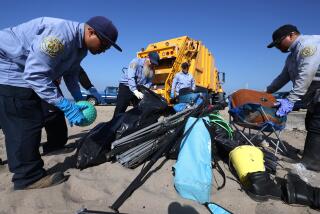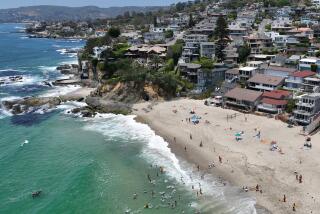Beach Combers : At Crack of Dawn, Cleanup Crews Hit the Sand to Collect Trash, Restore Beauty to County Coastline
- Share via
They are the first people on the beach. They arrive before the swarms of surfers and sunbathers, before the roller-bladers begin grinding on the boardwalk. It is still dark, and they stand alone amid the sand, the sea, and the stuff you left behind.
They are the people who clean up the beach, dozens of deeply tanned city, county and state workers who comb the coast at the crack of dawn, driving tractors to smooth the sand and sift out debris, dumping cans filled with the previous day’s litter.
“Everything you can think of, we find,” said Dan Davis, leader of Seal Beach’s cleanup crew, listing bowling balls, car engines and skis as a few choice items.
Davis says he regularly sees hypodermic needles, diapers and condoms. “All sorts of wonderful things,” he said, smiling. About 70% of the garbage he collects consists of foam cups or plastic, he said, while another big chunk is cans and bottles.
And there’s always the towels, T-shirts and “dozens of socks,” which Davis washes and uses as rags for cleaning the tractor equipment. Driftwood, flotsam and loads of seaweed clutter the coastline each morning.
Sometimes, there’s something unusual, such as the broken-down couch that sat under a lifeguard stand at Newport Beach’s Wedge on Wednesday.
“You never know what people are going to leave down on the beach,” said Joe Delgado, a Newport Beach maintenance supervisor. “But mostly it’s just trash.”
Trash. Tons of it land on Orange County’s beaches each day, polluting the area’s prime tourist attraction.
About 10 tons a day are collected from Newport Beach’s six miles of coastline, according to Delgado. Up along the coastline, Huntington City Beach fills more than 700 dumpsters--22,000 cubic yards of garbage--a year. And with just 1.1 miles to clean, Seal Beach picks up about three tons each day in the summer.
The county grabs 80 tons each week off its five miles of public sand, and the state rakes in mountains of trash at its five Orange County beaches.
This Fourth of July weekend, the beaches will be overflowing with sunbathers. For the holiday cleanup crew, more people means only one thing: more garbage.
“It does get discouraging at times. You come in day after day and see the same thing,” Davis said. “But if people weren’t making a mess, we wouldn’t have a job.”
Behind a six-cylinder, diesel-powered tractor, Davis drags a 15-foot beach rake, pulling piles of sand laced with litter into neat rows. Later, he will roll over these piles with the sanitizer, a 12-foot-long machine that sifts through the sand and pops the debris into a bin.
After 12 years, Davis maneuvers the tractor and rake like a pro, sneaking under the pier with only six inches to spare, and swerving around trash cans to get the tough spots. To clean completely, Davis draws a curvy course, but before leaving an area he likes to retrace his steps so the tractor leaves the beach in a neat grid.
“If you’ve got to clean it, why not clean it in an orderly fashion rather than like a spider weaving a web on LSD or something?” he said. “It’s much better to do a thorough job than to hustle through and have to go over it twice.”
While Davis drives back and forth, the rest of the crew gives the pier its weekly wash, grinding soap into the walkway to scrape away bait and fish scraps. Later, they will empty Seal Beach’s 200 50-gallon trash cans, and then tackle the most daunting task: the restrooms.
“It’s not like cleaning the bathroom at home; you just take the garden hose and have at it,” Davis said. To discourage vandals, he keeps paint at the pier and instructs his men to attack graffiti on the spot. “My boss says: ‘If you get any more coats of paint on that thing you won’t be able to walk in,’ ” Davis said.
Seal Beach’s crew is small compared to its neighbors to the south, Huntington Beach and Newport Beach.
With a budget of nearly $800,000, the city of Huntington Beach adds 16 part-timers to its regular three-person beach crew during the summer, operations supervisor Jim Way said. With 3 1/2 miles of beach, Huntington Beach has twice as many trash cans as Seal Beach and six times the number of restrooms. Plus, its 250 public fire rings must be cleaned each day.
Newport Beach has the biggest crew--and the most space, with six miles on the main drag plus Corona del Mar and dozens of little coves around the bay. “It’s a lot of beach to clean,” Delgado said.
With an average 85,000 people hitting its beaches each day during the summer, the city adds eight seasonal workers to its regular 12-person staff. “You’ve got to clean it, there’s no way around it,” Delgado said. “You can’t leave it there, that’s for sure.”
With that mission in mind, James Wood on Wednesday cruised the beach atop his Beach King, a state-of-the-art machine that combines the work of the rake and the sanitizer and leaves more sand on the beach. He began at water’s edge, covering the length of the beach with straight lines, but as the morning wore on, he shifted to “spot cleaning,” careful to avoid trash cans, poles for volleyball nets and people.
A green-and-yellow soda bottle standing upright in the sand is an easy target for Wood. The bottle is lifted by the Beach King’s seven-inch blade, spun through its paddle wheel, and bounced up onto a metal screen that rolls it into the bin behind.
On other days, the Newport Beach crew will clean the coves by hand, sweep the boardwalks or wash the glass atop the wall along Coast Highway. “We do a little bit of everything,” Delgado said as he cruised the beach to check on his crew. “Whatever needs to be done we do it.”
All along the coast, beach cleaners said they love their jobs despite the strange hours, the thanklessness and the trash. After all, they get to spend the day on the beach.
But even the beach can lose its luster when it doubles as the office. “I can’t appreciate the view,” Delgado complained. “I notice the trash first.”
Adopt-A-Beach Litter Pickup
The Adopt-A-Beach Program is a one-day coastline cleanup program sponsored by the California Coastal Commission. Last year, on Sept. 19, more than 30,000 people walked up and down California’s coastline picking up litter. Statewide, their combined efforts netted 320,000 pounds of trash. In Orange County last year, volunteers collected 42,571 pounds of trash, 5,000 pounds more than 1990.
The top 12 types of trash collected from Orange County beaches during the Adopt-A-Beach Program in 1991:
Number Percent of Total Category of Pieces Trash Collected 1. Cigarette butts 9,361 17.14 2. Styrofoam pieces 7,934 14.53 3. Paper pieces 3,497 6.40 4. Styrofoam cups 2,964 5.43 5. Plastic pieces 2,845 5.21 6. Plastic straws 2,070 3.79 7. Plastic caps/lids 1,924 3.52 8. Styrofoam packaging 1,822 3.34 9. Plastic food bags 1,791 3.28 10. Plastic cups 1,652 3.02 11. Metal bottle caps 1,404 2.57 12. Glass pieces 1,393 2.55
Source: California Coastal Commission Researched by APRIL JACKSON / Los Angeles Times
More to Read
Sign up for Essential California
The most important California stories and recommendations in your inbox every morning.
You may occasionally receive promotional content from the Los Angeles Times.










